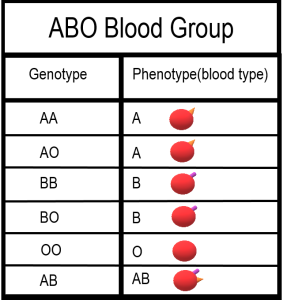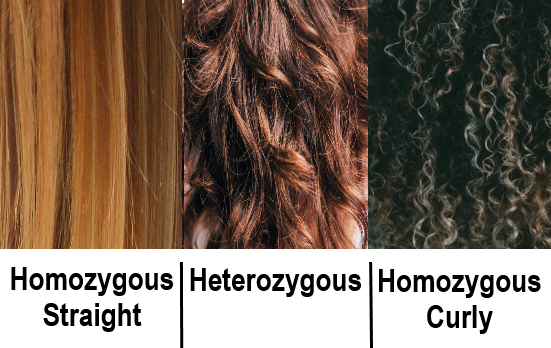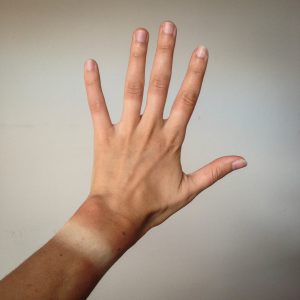8.4 Non-Mendelian Inheritance

This collage shows some of the variations in human skin colour, which can range from very light to very dark, with every possible gradation in between. As you might expect, the skin colour trait has a more complex genetic basis than just one gene with two alleles, which is the type of simple trait that Mendel studied in pea plants. Like skin colour, many other human traits have more complicated modes of inheritance than Mendelian traits. Such modes of inheritance are called non-Mendelian inheritance, and they include inheritance of multiple allele traits, traits with codominance or incomplete dominance, and polygenic traits, and pleiotropy. All of these modes are described below.

Figure 8.4.2 Description
A chart showing the relationship between genotypes and phenotypes in the ABO blood group system. It has two columns: “Genotype” and “Phenotype (blood type).” The possible genotypes and their corresponding blood types are:
AA → A
AO → A
BB → B
BO → B
OO → O
AB → AB
Each phenotype is illustrated with a red blood cell icon, with small coloured markers representing antigens on the cell surface, depending on the blood type.
Multiple Allele Traits
Most human genes are thought to have more than two normal versions or alleles. Traits controlled by a single gene with more than two alleles are called multiple allele traits. An example is the ABO blood type. Your blood type refers to which of certain proteins called antigens are found on your red blood cells. There are three common alleles for this trait, which are represented by the letters A, B, and O.
As shown in the table, there are six possible ABO genotypes because the three alleles, taken two at a time, result in six possible combinations. The A and B alleles are dominant to the O allele. As a result, both AA and AO genotypes have the same phenotype, with the A antigen in their blood (type A blood). Similarly, both BB and BO genotypes have the same phenotype, with the B antigen in their blood (type B blood). No antigen is associated with the O allele, so people with the OO genotype have no antigens for ABO blood type in their blood (type O blood).
Codominance
Look at the genotype AB in the ABO blood group table. Alleles A and B for the ABO blood type are neither dominant nor recessive to one another. Instead, they are codominant. Codominance occurs when two alleles for a gene are expressed equally in the phenotype of heterozygotes. In the case of ABO blood type, AB heterozygotes have a unique phenotype, with both A and B antigens in their blood (type AB blood).
Knowing your ABO blood type is crucial in emergencies, as it can save your life during a blood transfusion. If you receive blood with an antigen your blood lacks, your antibodies will recognize it as foreign and cause agglutination, where the transfused red blood cells clump together. This reaction is serious and potentially fatal. Understanding the antigens and antibodies in each ABO blood type helps determine which blood types you can safely receive.
If you have blood type A, your red blood cells have the A antigen, and your blood plasma contains anti-B antibodies. If you were to receive a transfusion of type B or type AB blood, both of which have the B antigen, your anti-B antibodies would attack the transfused red blood cells, causing agglutination.
People with blood type O are universal donors because their blood lacks A and B antigens, causing no immune reaction when transfused into others. Conversely, individuals with blood type AB are universal recipients since they have no anti-A or anti-B antibodies, allowing them to receive blood from any ABO type.

Figure 8.4.3 Description
A diagram showing the ABO blood group system based on antigens and antibodies. Four red blood cells are labelled A, B, AB, and O.
Type A cells have A antigens (pink circles) on their surface and anti-B antibodies (blue Y-shaped structures) in the plasma.
Type B cells have B antigens (blue diamonds) and anti-A antibodies (pink Y-shaped structures).
Type AB cells have both A and B antigens and no antibodies, making them universal recipients.
Type O cells have no surface antigens or anti-A and anti-B antibodies, making them universal donors.
The diagram explains the compatibility of blood transfusions based on immune responses.
Incomplete Dominance
Another relationship between alleles for the same gene may be incomplete dominance. This occurs when the dominant allele is not completely dominant. In this case, an intermediate phenotype results in heterozygotes who inherit both alleles. Generally, this happens when the two alleles for a given gene both produce proteins, but one protein is not functional. As a result, the heterozygote individual produces only half the amount of normal protein as is produced by an individual who is homozygous for the normal allele.
An example of incomplete dominance in humans is Tay Sachs disease. In this case, the normal allele for the gene produces an enzyme responsible for breaking down lipids. A defective allele for the gene results in the production of a nonfunctional enzyme. Heterozygotes who have one normal and one defective allele produce half as much functional enzyme as the normal homozygote, and this is enough for normal development. Homozygotes that have defective alleles, however, produce only nonfunctional enzymes. This leads to the accumulation of lipids in the brain starting in utero, which causes significant brain damage. Most individuals with Tay Sachs disease die at a young age, typically by the age of five years.
Another good example of incomplete dominance in humans is hair type. There are genes for straight and curly hair, and if an individual is heterozygous, they will typically have the phenotype of wavy hair.

Figure 8.4.4 Description
An image illustrating incomplete dominance in hair texture inheritance. It shows three side-by-side photos of different hair types. The left panel displays straight hair labelled “Homozygous Straight,” the center panel shows wavy hair labelled “Heterozygous,” and the right panel features tightly curled hair labelled “Homozygous Curly.” This demonstrates how individuals with one straight and one curly hair allele exhibit a blended, intermediate phenotype—wavy hair.
Polygenic Traits
Many human traits are controlled by more than one gene. These traits are called polygenic traits. The alleles of each gene have a minor additive effect on the phenotype. There are many possible combinations of alleles, especially if each gene has multiple alleles. Therefore, a whole continuum of phenotypes is possible.
An example of a human polygenic trait is adult height. Several genes, each with more than one allele, contribute to this trait, so there are many possible adult heights. Adult height ranges from less than 5 feet to more than 6 feet, with males, on average, being somewhat taller than females. Most people fall near the middle of the range of heights for their sex, as shown in Figure 8.4.4.

Figure 8.4.5 Description
A bell curve graph comparing the height distributions of men and women. The x-axis represents height in inches (ranging from 55 to 85), and the y-axis represents frequency as a percentage (0% to 60%). The blue curve represents women, peaking around 64–65 inches, while the red curve represents men, peaking around 69–70 inches. The curves overlap in the middle, showing that some women are taller than some men, but overall, men tend to be taller. The graph illustrates continuous variation in height, a polygenic trait influenced by multiple genes.

Many traits are affected by the environment, as well as by genes. This may be especially true for polygenic traits. Adult height, for example, might be negatively impacted by poor diet or childhood illness. Skin colour is another polygenic trait. There is a wide range of skin colours in people worldwide. In addition to differences in genes, differences in exposure to ultraviolet (UV) light cause some variation. As shown in Figure 8.4.5, exposure to UV light darkens the skin.
Pleiotropy
Some genes affect more than one phenotypic trait. This is called pleiotropy.

There are numerous examples of pleiotropy in humans. They generally involve important proteins that are needed for the normal development or functioning of more than one organ system. An example of pleiotropy in humans occurs with the gene that codes for the main protein in collagen, a substance that helps form bones. This protein is also important in the ears and eyes. Mutations in the gene result in problems not only in bones but also in these sensory organs, which is how the gene’s pleiotropic effects were discovered.
Another example of pleiotropy occurs with sickle cell anemia. This recessive genetic disorder occurs when there is a mutation in the gene that normally encodes the red blood cell protein called hemoglobin. People with the disorder have two alleles for sickle cell hemoglobin, named for the sickle shape (pictured in Figure 8.4.6) that their red blood cells take on under certain conditions (like physical exertion). The sickle-shaped red blood cells clog small blood vessels, causing multiple phenotypic effects, including stunting physical growth, certain bone deformities, kidney failure, and strokes.
Exercise 8.4.1
Text Description
A trait for which each allele of the heterozygote makes an equal contribution to the phenotype is most likely a ____.
A trait controlled by a single gene that has three different alleles is most likely a ____.
A trait controlled by a single gene where one allele is fully dominant to the only other allele is most likely a ____.
- codominant trait
- multiple allele trait
- mendelian trait
- polygenic trait
2. People with O type blood cannot receive a blood transfusion from anyone besides others with O type blood. (True/False)
3. People with O type blood can be heterozygous for this trait. (True/False)
4. Human traits can be influenced by the environment. ( True/False)
1. A trait controlled by four genes is most likely a polygenic trait.
A trait for which each allele of the heterozygote makes an equal contribution to the phenotype is most likely a codominant trait.
A trait controlled by a single gene that has three different alleles is most likely a multiple allele trait.
A trait controlled by a single gene where one allele is fully dominant to the only other allele is most likely a Mendelian trait.
2. True
3. False
4. True
“5.14 Non-Mendelian Inheritance” from Human Biology by Christine Miller is licensed under a Creative Commons Attribution-NonCommercial 4.0 International License, except where otherwise noted.

